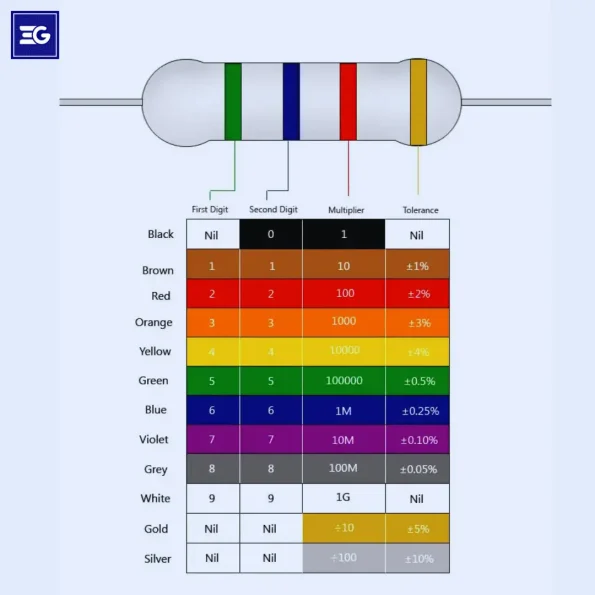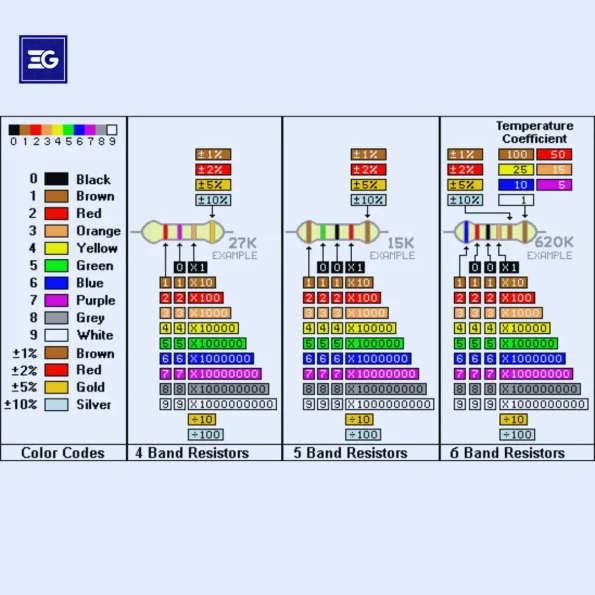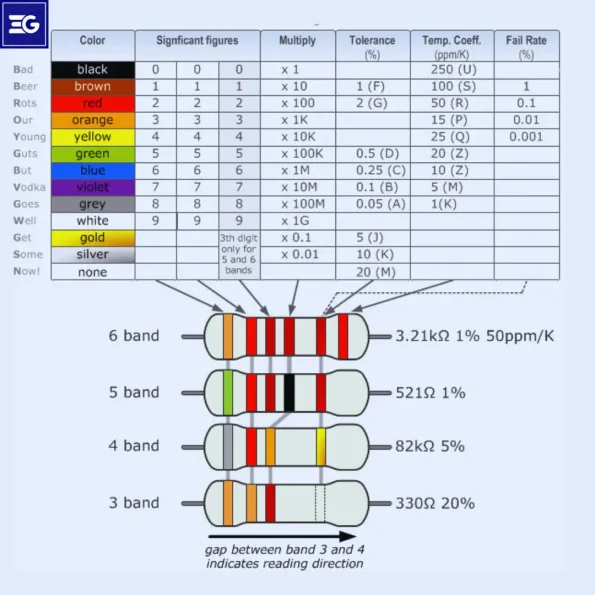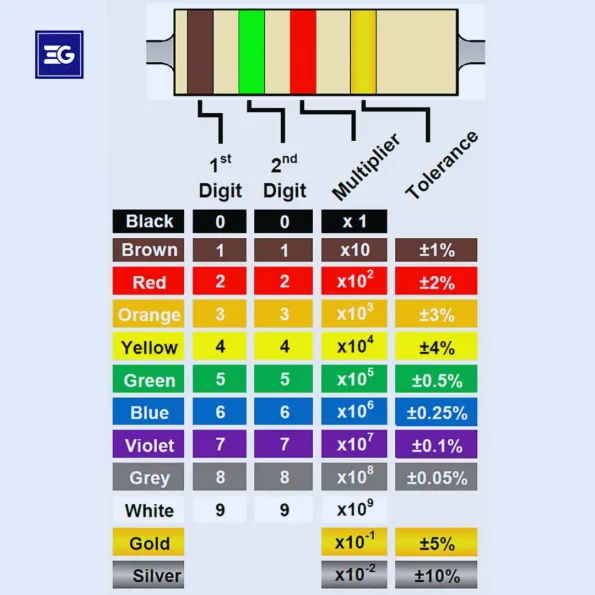Understanding the Resistance Color Code: A Comprehensive Guide
When you’re working on electronics projects, one of the most important skills you should have for understanding how to read and discriminate the resistance color code is learned. The color coding system in which the resistors are the most crucial electrical components used in electrical circuit and indicates the value of the resistance. If you know how to decode the resistance color code you can easily pick the right resistor for a given circuit, and make sure that it performs to its fullest potential.
In this guide, we will show you how to understand and use the resistance color code, how to avoid the most common mistakes related to the resistance color code, and real world use of this knowledge. With these, you’ll be able to troubleshoot, optimize and build better electronic projects.

Resistance: Why Is It Important in Electronics?
Before we look into the specifics of the color code system, it is worth knowing the basics of what is resistance. Resistance, in the simplest terms, is how much resistance a material, in general, provides to electric current. All electronic circuit components have some resistance. It informs your circuit how much current will pass through the circuit, when a voltage is applied. Ohms (Ω) is how resistance is measured the same person who suggested Ohm’s law is Georg Simon Ohm.
In Resistors, resistance is the important role to electronic components. Resistors are particularly developed to keep or control the amount of present streaming in any circuit to protect overloading and they are maintained in shape to keep other components in shape also. To design the safe and functioning circuits, we must know the exact resistance value of the resistor.

The Resistance Color Code: What Are the Color Bands?
Also, there is this resistance color code to represent the value of resistors. Resistors typically have four color bands printed on them, although some resistors may not have five or six. These are numbers that denote certain bands representing, ohms, the resistor value. In most cases, resistors are color-coded with the following bands:
Band 1 & 2: The first digits in the value of the resistor are represented by the first two bands.
Band 3: The multiplier is the third band that will tell us how many zeros should be added to(digits).
Band 4: Fourth band is the tolerance of resistor, and this is showing how much the resistor’s value can vary.
The colors are based on a standard code, where each color corresponds to a specific number:
Black = 0
Brown = 1
Red = 2
Orange = 3
Yellow = 4
Green = 5
Blue = 6
Violet = 7
Gray = 8
White = 9

How to Decode the Resistance Color Code in 7 Easy Steps
While the concept of reading the resistance color code may seem complex at first, it becomes much easier when broken down into a few simple steps. Follow these steps to decode the value of any resistor:
-
- Identify the Color Bands
The first step in reading a resistor is identifying the color bands on the resistor. These are usually printed in sequence along the resistor’s body.
- Identify the Color Bands
-
- Decode the First Two Bands (Digits)
The first two bands represent the first two digits of the resistance value. For example:
- Decode the First Two Bands (Digits)
Brown = 1
Red = 2
Green = 5
So, if the first two bands are brown and red, the digits are 1 and 2, making the first part of the resistance value 12.
-
- Identify the Multiplier (Third Band)
The third band indicates the multiplier, which is a power of ten. It tells you how many zeros to add to the first two digits. Here’s how the multiplier works:
- Identify the Multiplier (Third Band)
Black = ×1
Brown = ×10
Red = ×100
Orange = ×1,000
For example, if the third band is red, it means you should multiply by 100, giving you a total value of 1,200 ohms (12 × 100).
-
- Check the Tolerance (Fourth Band)
The fourth band indicates the tolerance of the resistor, showing how much the actual resistance value could vary from the stated value. Common tolerance values are:
- Check the Tolerance (Fourth Band)
Gold = ±5%
Silver = ±10%
For example, if your resistor has a tolerance band of gold, the actual resistance value could vary by 5% above or below the stated value.
-
- Come up with the value of the resistor.
And now you can calculate the output value. For example, if your resistor has the color bands brown, red, and red:
- Come up with the value of the resistor.
First two digits: 1 and 2 = 12
Multiplier: Red = ×100
Result: 12 × 100 = 1,200 ohms
-
- Double-Check the Tolerance
Finally, check tolerance band to know resistor’s actual value can vary how much. If it’s gold, the resistor could range from ±5% From 1,140 ohms to 1,260 ohms.
- Double-Check the Tolerance
-
- Verification should be done using a Multimeter. A multimeter is a useful tool to use simply to double check the value if you’re ever unsure what a given resistor is worth. The resistance (ohms) setting on your multimeter should then be set and you should measure the resistance directly for verification of the value.

Top Mistakes To Avoid While Decoding Resistance Color Codes
While reading the resistance color code may seem straightforward, there are a few common mistakes that beginners (and sometimes even experienced hobbyists) often make:
Misinterpreting Color Bands: Reading the color bands is one of the most common mistakes. Such as confusing red and brown or violet and blue might result in wrong calculation. You always want to have good lighting and use magnifying glass if needed.
Overlooking Tolerance: The fourth tolerance band is often overlooked and this leads people to an inaccurate expectation of what the resistor’s performance will be. Tolerance always checks as it can mean your resistance can be within a range tolerant amount, so make sure you check this prior to soldering.
Incorrect Multiplier Application: The multiplier is misinterpreted sometimes, resulting in undeniably incorrect values. Double check the multiplier and make sure you’re multiplying the right digits.
Resistance Color Code: Practical Applications
After learning how to decode the resistance colour code, you may be wondering why it’s important. The practical applications of this skill are widespread:
Building Circuits: The most immediate use lies in the design and manufacturing of electronic circuits. Whenever you pick the proper resistor, you can be confident that the electrical circuit works like it’s supposed to and that your components do not get overly stressed.
Troubleshooting: You can troubleshoot existing circuits knowing the value of resistors. In such a case, checking the resistors looking at the values and making sure they’re the values you want help you to find and fix the problem.
Prototyping: The resistance color code is crucial for the engineers and designers to prototype a new product. An important aspect of prototyping process is ability to easily recognize and utilize resistors with certain values.
















